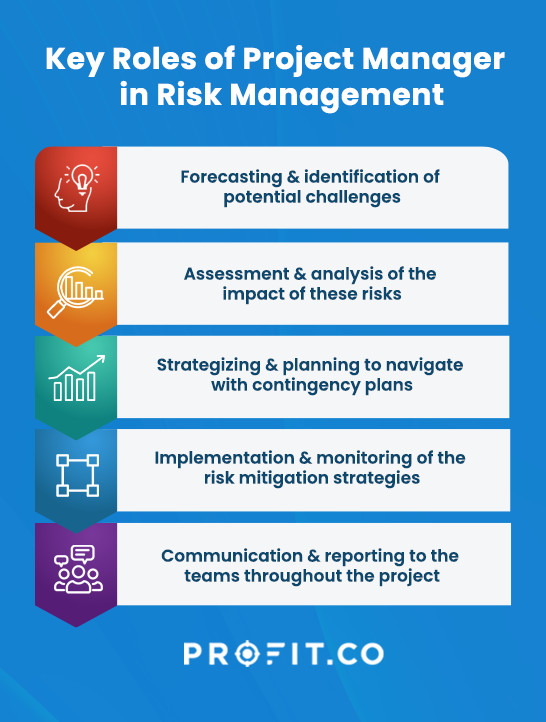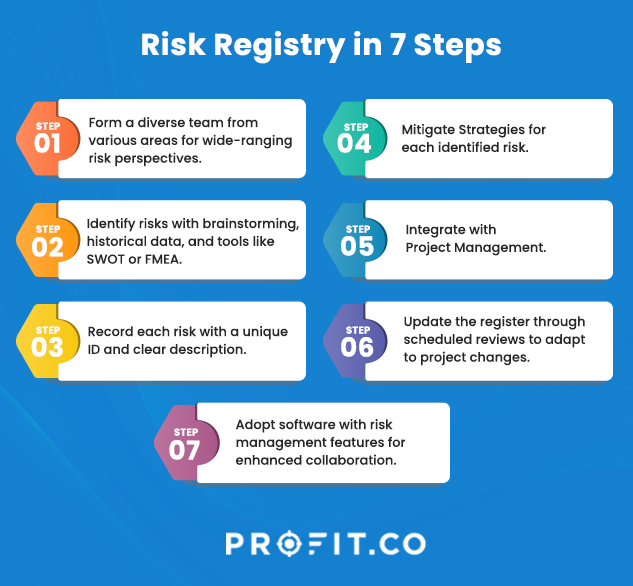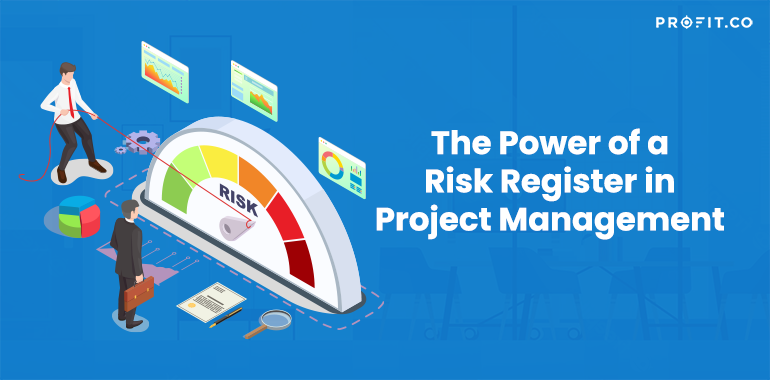Recognizing and addressing risks is paramount for successfully delivering projects within the predetermined scope, time, and budget while maintaining the expected quality standards. It involves the early detection of potential pitfalls, evaluating their potential impact, and crafting strategies to mitigate or avoid these risks. Managing risks effectively not only diminishes the likelihood of project failure but also significantly enhances the probability of a project’s success.
Imagine a single, organized hub for all your project’s potential roadblocks. That’s the magic of a risk register – a vital tool in any project manager’s arsenal. This comprehensive document goes beyond just listing threats; it’s a dynamic strategy center, empowering you to identify, assess, and effectively counter risks before they derail your progress.
Think of it as a map charting the treacherous terrain of uncertainty. By pinpointing potential dangers and crafting smart responses, you and your team can confidently navigate challenges, making informed decisions that keep your project on track and thriving.
Understanding Project Risks
Understanding project risks is a fundamental aspect of effective project management. Risks are potential events or conditions that, if they occur, could positively or negatively impact a project’s objectives. The nature of these risks can vary widely, encompassing everything from technical challenges, resource shortages, and financial constraints to regulatory changes, environmental factors, and stakeholder expectations. The key to managing these risks is not to eliminate them which is often impossible but to understand and mitigate their potential impact on the project.
Learn how to anticipate, document, and mitigate risks like a pro!
What is a Risk Register?
A Risk Register, also known as a Risk Log, is a crucial tool in project management and risk management processes. It serves as a comprehensive document or database where all identified risks associated with a project are recorded and tracked over time. The primary purpose of a Risk Register is to provide a systematic approach to managing project risks by documenting their nature, their potential impact on the project, and the strategies planned or implemented to mitigate or manage these risks.
“The greatest artists like Dylan, Picasso and Newton risked failure. And if we want to be great, we’ve got to risk it too.”
Importance of Identifying and Managing Risks in a Project
Identifying and managing risks in a project is pivotal for its success and seamless execution. This process serves a dual purpose: it anticipates potential problems and devises effective strategies for navigating or mitigating them.
- Identifying and managing risks early in a project anticipates potential issues, allowing for the development of effective strategies to navigate or mitigate them.
- Proactive risk management increases the likelihood of completing projects on time, within budget, and to the desired quality standards.
- Effective risk management identifies and prioritizes areas at greatest risk, enabling more efficient allocation of resources and improved decision-making.
- Demonstrating clear control over potential project problems through structured risk assessment and management increases confidence among stakeholders.
- Incorporating risk management into the project planning process ensures optimal use of resources and informed decision-making regarding potential risks and their implications
- A proactive approach to risk management reduces the likelihood of cost overruns and delays by addressing issues before they escalate.
- Managing risks proactively allows project teams to adapt more effectively to changes and unforeseen events, enhancing project resilience.
- A thorough analysis of project outcomes, focusing on risk management successes and failures, contributes to refining risk management practices and overall project management strategies.
The Role of a Project Manager in Risk Management
The project manager stands at the helm of risk management and is tasked with identifying, assessing, and mitigating potential risks to safeguard the project’s objectives. Central to the project management process, they are instrumental in cultivating a risk-aware culture within the team, ensuring that risk management is seamlessly woven into the fabric of project planning and execution. Below, we delve into the pivotal responsibilities that underscore the project manager’s role in navigating project risks.

Proactive Risk Identification
A project manager’s journey in risk management begins with proactive risk identification. This step gathers insights from team members, stakeholders, and experts, supplemented by lessons from historical project data, to compile a comprehensive risk inventory. The aim is to leave no stone unturned, ensuring every potential threat is brought to light.
Rigorous Risk Analysis and Assessment
Following identification, the project manager thoroughly analyzes and assesses risks, determining their likelihood and potential impact. This process involves ranking risks by severity and probability, employing both qualitative and quantitative methods to understand how each risk could influence project timelines, costs, scope, and quality.
Strategic Risk Response Planning
Crafting strategies to tackle identified risks is a cornerstone of the project manager’s role. Decisions on whether to avoid, mitigate, transfer, or accept risks lead to the development of tailored response plans for significant threats, including allocating resources and preparing contingency measures for high-impact risks.
Coordinated Implementation of Risk Response Strategies
The execution of risk response strategies requires meticulous coordination with the project team and stakeholders. The project manager ensures these strategies are integrated into the overall project plan and clarifies team members’ roles in their implementation, ensuring a unified approach to managing risks.
Continuous Monitoring and Reporting
Vigilant monitoring of risks and the effectiveness of response strategies is essential. The project manager tracks ongoing risks, identifies new ones as the project evolves, and assesses the success of implemented strategies. Regular updates to stakeholders about risk management efforts are vital for transparency and keeping all parties informed about potential project impacts.
Cultivating a Risk-Aware Culture
Lastly, the project manager is key to fostering a culture prioritizing risk awareness among the project team and stakeholders. This involves promoting open dialogue about risks, supporting training initiatives, acknowledging successful risk management practices, and embedding risk consciousness into the project’s ethos.
The project manager’s role in risk management is foundational to ensuring risks are systematically identified, analyzed, and mitigated across the project lifecycle. Through diligent execution of these responsibilities, the project manager significantly bolsters the project’s prospects for success, minimizes unforeseen hurdles, and guarantees the project’s intended value delivery.
9 Components of a Risk Register
A Risk Register is a key document in project management, designed to capture and track all potential risks a project might face. Its complexity can vary depending on the project’s size and scope, but certain core elements should be included to ensure comprehensive risk management. Here’s a breakdown of the nine crucial components every Risk Register should encompass:
1. Risk Identification
The process begins with naming and assigning a unique ID to each risk for organized tracking. Sources for identifying risks include analyzing historical data from similar projects, brainstorming sessions, and considering both known and unknown potential risks. This step is crucial for laying the groundwork for effective risk management.
2. Risk Description
Each risk is accompanied by a concise yet descriptive explanation, helping team members and stakeholders quickly grasp its essence. Descriptions should cover who the risk affects, its potential consequences, and any relevant details that clarify its nature.
3. Risk Category
Risks are categorized to highlight their relevance across project stages and areas such as budget, schedule, resources, operations, technology, and quality. Categorization aids in risk analysis and prioritization by distinguishing between various types of risks.
4. Risk Owner
Assigning a risk owner ensures that each risk has a designated individual or department responsible for monitoring and managing its resolution, fostering accountability within the project team.
5. Risk Probability
This element evaluates the likelihood of each risk occurring, using both qualitative assessments and quantitative data where available. Understanding risk probability assists in prioritizing risks based on their chances of impacting the project.
6. Risk Mitigation
Mitigation strategies are outlined for each risk, specifying the actions to be taken to prevent or minimize its impact. Complex mitigation plans may require detailed discussions and could be documented separately for clarity.
7. Risk Impact
Assessing the potential damage or impact of each risk helps in understanding its severity. This evaluation considers whether a risk poses a significant threat to the project or if its effects are more manageable.
8. Risk Priority
Risk priority is determined by assessing both the impact and probability of risks. This can be done through a calculated score in quantitative analyses or a qualitative approach, guiding the allocation of resources towards the most critical risks.
9. Risk Status
Lastly, tracking the status of each risk (open, in progress, or closed) provides a current view of risk management efforts and progress. Regular updates ensure the Risk Register remains an accurate and dynamic tool for managing project risks.
Incorporating these nine components into a Risk Register enables project teams to manage risks systematically, ensuring informed decision-making decision-making and enhancing the project’s chances of success. Regular reviews and updates to the Risk Register are essential to maintain its relevance and effectiveness throughout the project lifecycle.
7 Steps to Establish a Robust Risk Register for Your Project
A well-established risk register is your project’s central hub for identifying, assessing, and mitigating potential threats. Here’s a formal outline of the 7 key steps to create and maintain an effective risk register:
1. Assemble a Diverse Risk Management Team
Convene a cross-functional team representing various project stakeholders and expertise. This ensures comprehensive risk identification from diverse perspectives.
2. Conduct a Thorough Risk Identification Exercise
Employ techniques like brainstorming, historical data analysis, and expert consultations to capture potential risks across all project areas. Use risk identification tools like SWOT analysis or Failure Modes and Effects Analysis (FMEA) for a structured approach.
3. Document Risks Clearly
For each identified risk, create a detailed entry within the register with a unique identifier for easy reference with a clear description that is understandable to all stakeholders
4. Develop and Assign Mitigation Strategies:
For each identified risk, determine an appropriate mitigation strategy based on its nature and severity.
5. Integrate the Risk Register with Project Management
Ensure the risk register is integral to the overall project plan, not a standalone document.
6. Establish a Regular Review and Update Process:
- Schedule regular reviews (e.g., weekly, monthly) of the risk register to:
- Assess any changes in the project environment or risk landscape.
- Evaluate the effectiveness of implemented mitigation strategies.
- Identify and address new or emerging risks.
Update the register accordingly to maintain its accuracy and relevance.
7. Leverage Technology for Efficiency and Collaboration:
Explore project management software with built-in risk management features or Consider dedicated risk management tools for advanced functionalities like risk heat maps and Monte Carlo simulations. Utilize technology for automatic updates, reminders, and easy sharing of the risk register among team members and stakeholders.
Remember, a well-maintained register is a powerful tool for navigating uncertainties, mitigating threats, and ensuring your project’s success.

Understanding the Power of OKR
Best Practices in Managing a Risk Register
Managing a risk register effectively is crucial for the success and smooth execution of any project. A risk register, a tool used to identify, assess, and manage potential risks, is pivotal in risk management processes. Here are some best practices for managing a risk register:
Establish a Clear Process for Risk Identification
- Encourage participation from all team members across different functions to contribute to risk identification.
- Use brainstorming sessions, historical data, and lessons learned from previous projects to identify potential risks.
Assess Risks Systematically
- Evaluate each identified risk for its likelihood of occurrence and potential impact on the project.
- Utilize a standardized risk matrix to categorize risks and prioritize them effectively.
Assign Ownership for Each Risk
- For every risk entered in the register, assign a risk owner. This person is responsible for monitoring the risk and implementing mitigation strategies.
Develop and Document Mitigation Strategies
- For each risk, define actionable mitigation or contingency plans. Document these plans in the risk register.
- Strategies could involve:
Avoid: Eliminate the risk altogether by changing the project plan or scope.
Mitigate: Reduce the likelihood or impact of the risk through actions like training, redundancy, or contingency plans.
Transfer: Shift the risk to another party through insurance, contracts, or outsourcing.
Accept: Acknowledge the risk and its potential consequences but take no specific action to address it.
Communicate Risks Effectively
- Keep all project stakeholders informed about the risks and the actions being taken to manage them.
- Use the risk register as a communication tool to ensure transparency and facilitate discussion on risk management strategies.
Learn from Risks
- Review the risk register after the project’s completion to identify what was learned about each risk.
- Use these insights for continuous improvement in risk management practices for future projects.
Risk Management Tools
- Project management software: Integrates risk management with project planning and execution.
- Dedicated risk management software: Offers advanced features for risk assessment, tracking, and reporting.
- Spreadsheets: Can be used for basic risk management, but lack advanced functionality.
By adhering to these best practices, organizations can ensure that their risk registers are comprehensive, up-to-date, and effective in managing project risks. This proactive approach to risk management helps mitigate potential issues and contributes to the overall success and timely delivery of projects.
Real-world Examples
Construction of the Burj Khalifa
Overview: The construction of the Burj Khalifa, the world’s tallest building, presented numerous risks, from engineering challenges to logistical and safety concerns.
Risk Management: The project team used a comprehensive risk register to identify and manage risks. High-impact risks, such as supply chain disruptions for materials needed to reach such unprecedented heights, were meticulously planned for and mitigated.
Outcome: Effective use of the risk register allowed for proactive management of potential issues, ensuring safety and keeping the project on schedule and budget. The Burj Khalifa stands as a testament to successful project and risk management on a massive scale.
London Olympics 2012
Overview: The London Olympics 2012 was a highly complex project with a tight schedule and significant public scrutiny.
Risk Management: The organizing committee developed a dynamic risk register that was regularly updated. It included risks related to security, construction delays, and budget overruns.
Outcome: The proactive and systematic approach to risk management contributed to the event’s success, with all venues completed on time and within budget, and the games running smoothly.
Lessons Learned from Inadequate Risk Management
Denver International Airport (DIA) Baggage System Project
Overview: The project aimed to implement an advanced automated baggage handling system at DIA.
Challenges: The project faced significant delays and cost overruns, partly due to inadequate risk management. Critical risks, such as technological challenges and system testing, were underestimated.
Lessons Learned: The failure highlighted the importance of comprehensive risk identification, realistic assessment of technological innovations, and the need for contingency planning. It serves as a cautionary tale on the consequences of neglecting thorough risk management.
Fukushima Daiichi Nuclear Disaster
Overview: The disaster was precipitated by the Tohoku earthquake and tsunami in Japan in 2011.
Challenges: Among the root causes was the inadequate preparation for a tsunami of the scale that hit the plant, despite historical evidence suggesting the possibility.
Lessons Learned: The incident underscored the critical importance of preparing for low-probability but high-impact risks. It highlighted the need for robust risk assessment models that consider all possible scenarios, no matter how unlikely they may seem.
These examples demonstrate the wide-ranging applicability and critical importance of effective risk management and the use of risk registers across different industries. From construction and event planning to technology projects and disaster preparedness, the lessons learned underscore the need for thorough risk identification, assessment, and proactive management to safeguard project outcomes and key performance indicator (KPI) organizational objectives.
Final Thoughts
Ultimately, the effectiveness of a risk register hinges on its regular review, timely updates, and the active involvement of the entire project team. When used correctly, it can be the difference between a project’s success and failure. As we move forward in an ever-changing project landscape, the role of the risk register will only grow in importance, acting as a beacon that guides projects through the uncertainties of tomorrow. Let us embrace the power of the risk register, leveraging its insights to navigate risks and seize opportunities, ensuring our projects not only survive but thrive in the face of challenges.
Ready to start your journey to optimizing your business
Related Articles
-
The Ultimate Guide to Crafting Engaging Project Status Reports
The world of project management can feel like a constant battle against the clock. Deadlines loom, tasks multiply, and keeping... Read more
-
Mastering Effective Work Planning with the Right Project Management Tools
Ever feel like you're constantly chasing down tasks and deadlines? You meticulously plan every project detail, create beautiful Gantt charts,... Read more
-
How can the Critical Path Method Guide you in Project Planning?
Introduction You've been handed the keys to a complex project, with deadlines looming and a team raring to go. But... Read more
-
How to Master Stakeholder Analysis for Project Success?
Introduction Picture yourself at the helm of an important project with high stakes. The atmosphere is charged, the team is... Read more

